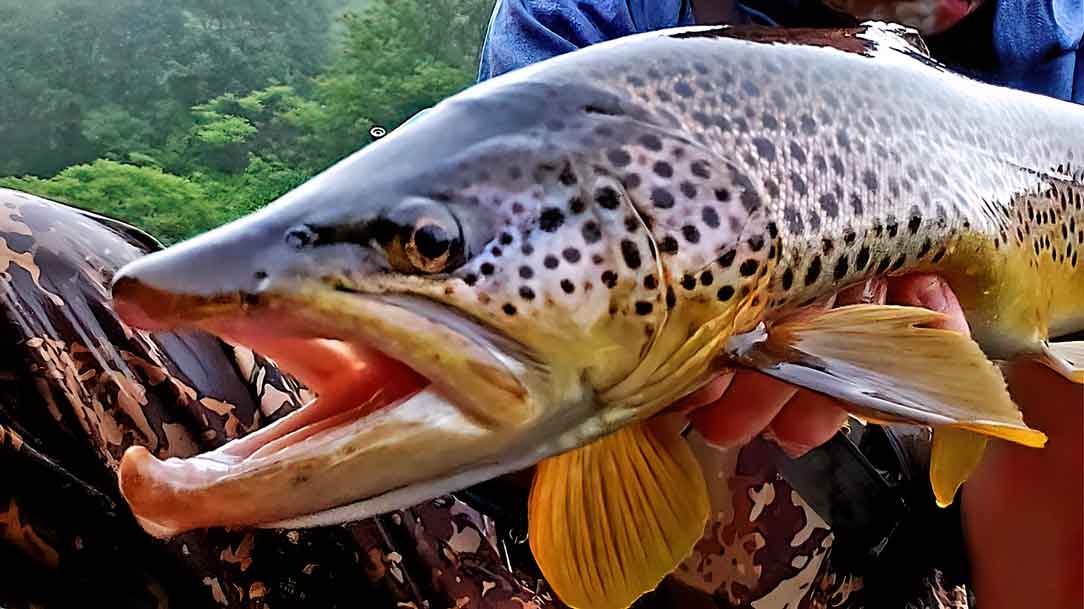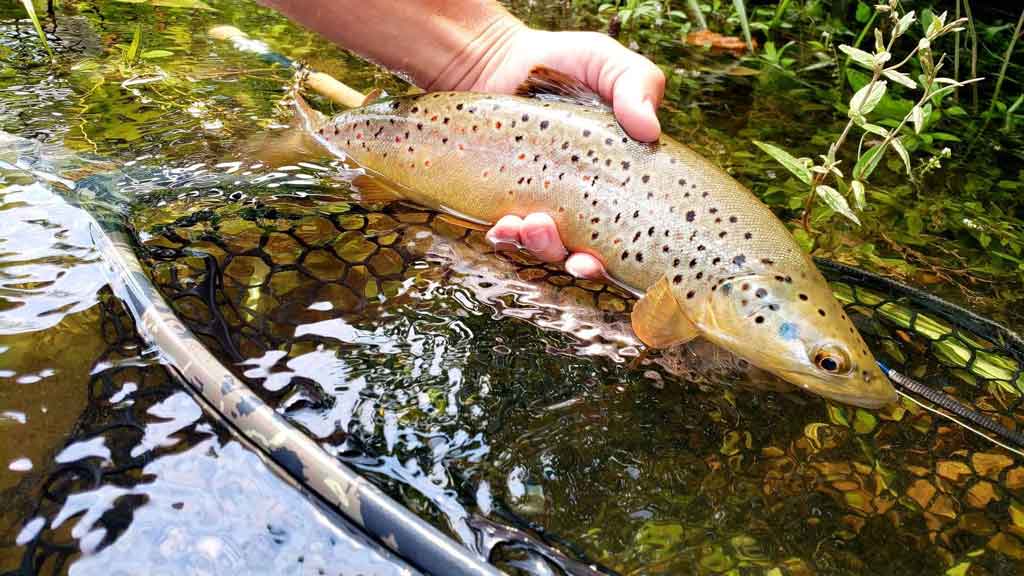Like all sports, fly fishing inspires strong opinions in its fan base. So it should come as no surprise that the question of dry flies vs. nymphs is hotly debated. And like all debates, there are two sides to the story. There are pros and cons to both dry flies and nymphs, but are dry flies better than nymphs?
As a general rule, Dry Flies are more successful when trout are feeding on the surface. But on average, Nymphs are going to be more successful throughout any given time of the year.
The answer to which is the best may depend on the situation. So let's start by examining both options.

Dry Flies
Dry flies are what most people imagine when they think of fly fishing in their heads. Dry flies are designed to sit on the water's surface and mimic insects poised to fly away or insects that have landed on the water's surface.
Many dry flies are made to look like the adult version of wet flies, which could be the larval or nymph stage of semi-aquatic insects, while others are made to look like injured or trapped land-based insects (like beetles or grasshoppers). However, dry flies are light enough not to break the water's surface tension, and while they may make minor ripples to attract fish, they disrupt the water less than wet flies.

Dry fly fishing can be more complex than nymph fly fishing, and mastering good casting techniques can be frustrating for inexperienced or beginner anglers. When using nymphs, there is a delay between when the bait touches the water and when the fish notices the fly for the first time. However, with dry flies, you'll be targeting fish willing to feed near the surface of the water, which means there's usually very little room for error. Also, because the fish are lower in the water, splashing or a poorly timed cast is less likely to startle them.
Dry flies, despite being more technically complex, can be more exhilarating than wet fly fishing since you can see all of the action right on the water's surface.

Nymphs
Nymphs, are designed to look like larvae or nymphs of semi-aquatic insects. They are either fished beneath the water's surface on a tight line presentation or floated off the bottom by way of an indicator (depending on your personal preference). Either way, these flies go underneath the water's surface and offer anglers a better opportunity to catch fish that are lower in the water column.
Nymphs are meant to be fished subsurface, so you'll need split shot or a weighted fly to keep it on the bottom of your fishing hole or stream. However, this also means you will need to rely on your indicator, which makes nymph fishing somewhat more difficult to recognize a strike verses dry fly fishing. Additionally, many nymph fly patterns are weighted, which means the fly is heavier than other flies. Heavy flies can be more difficult to cast and can take some getting used to for beginner anglers. They also have a greater chance of picking up debris in the water, leading to snags and lost gear.

While dry fly fishing usually requires some work to get the fly to the fish, nymph fishing is more patient and methodical. You'll have to cast your nymph over and over again. As mentioned before, dry flies are successful when fish are feeding at the surface.
Considerations When Using Both Types of Flies
Instead of thinking in terms of best and worst, it's more helpful to consider the situations where dry flies and nymphs work the best. While there are dozens of factors that can affect your decision on which type of fly to use, some of the main ones include:
Weather Conditions
Dry flies are good on warmer days when there is a greater chance at surface hatches, while nymphs work better on colder days and in small streams where rain has reduced the chance of fish being spooked by your fly.

Water Conditions
Both nymphs and dry flies are good in fast-moving rivers, but the fish in these areas will be more difficult to tempt. If you're fishing for trout in a stream or river, try targeting feeding lanes and sticking with nymphs.

Lighting Conditions
Nymphs work well in low-light periods like night or before sun up, while dry flies can also be used during dark hours. Nymphs are good for catching trout, steelhead, and salmon (provided the water is clean enough), while dry flies are also suited to catching bass, panfish, pike, and even muskie.
Be Prepared for Some Trial-And-Error
When using both types of flies, the key is to experiment. Fly fishing is its own unique sport in which you can use many different techniques when attracting or catching fish. Therefore, it's best to experiment with a few different flies and see which ones work best for you and the fish in your local waters.

Pros and Cons of Dry Flies and Nymphs
Let's take a deeper look at the pros and cons of dry flies and nymphs.
Dry Fly Fishing Pros
- Dry flies are much more visible, which means you'll know exactly when a fish has taken your fly. This makes it easier to land trout, panfish, and bass than nymph fishing.
- Dry fly fishing tends to be more visually active. It's what people usually think of when they imagine fly fishing in their heads.
Dry Fly Fishing Cons
- Dry fly fishing requires more arm movement and some practice to make sure you're getting the best cast. Unfortunately, this means that it's not always the best activity for beginners and young kids.
- Dry flies can scare fish away if the conditions are unsuitable and you don't get a good cast in. They're not that great for catching fish during cloudy days or low-light periods, either.
- Dry flies require much more technique to master than nymphs, so it requires more practice and patience to become competent.

Nymph Fly Fishing Pros
- Nymphs are great for young kids and beginners. If you're an experienced angler, nymph fly fishing can be good if you're looking to get some practice or show your children how it's done. It doesn't require as much movement or energy on the angler's part, which means it's perfect for a family trip.
- Nymphs are better during low-light periods and cloudy days. Anglers also get to take their time with nymph fishing, which means there's more opportunity for success if they know what they're doing.
- Nymphs are designed to resemble the larval stage of an insect, meaning they are not as detailed and therefore not as expensive.
Nymph Fly Fishing Cons
- Nymphs require more knowledge about bodies of water you're fishing in. If you're not an experienced angler or don't know much about reading the water, nymph fishing might seem difficult
- Nymphs are not as visible, which means it can be harder to spot the fish taking your fly. This makes it more time-consuming than dry fly fishing and means it requires more patience.
- Nymphs get lost much more frequently because of their small size, so even though they are less expensive, you may make up the difference by having to buy in bulk.

So Which Method is Best?
Many anglers make the mistake of choosing one method over another based on what they're in the mood for, which could lead to missed opportunities in both arenas. It's better to fish the fly that will work best for your skillset and the conditions at hand, rather than simply choosing nymphs or dry flies because you're impatient right then.
Nymph fishing is good when you know your way around a stream and take advantage of current and deep pools that nymphs can sink into. Also, many fish will lay around rocks or overhanging branches in shallower water and wait for food to come to them.
Fly fishing on lakes is best with dry flies since you'll be targeting fish higher up in the water column, usually looking for insects that fall from above or are carried by the breeze. Likewise, fly fishing during a hatch, where specific insects emerge at different times of the day or year, is best done with dry flies to ensure you're targeting the particular species of fish that are feeding on them at that time.
Bottom Line on Dry Flies and Nymphs
Remember, this is a sport that requires a lot of patience and practice, so it's best to keep an open mind when trying to determine which method you like better. Fly fishing is one activity where there isn't necessarily a wrong or right answer. Instead, the best technique will depend on personal preference and skill level, and what the fish are biting in your area.

About the Author
Matthew Bernhardt, a third-generation Coloradan, grew up at the forefront of the state’s fly-fishing revolution, enjoying time on the water, side by side with experienced guides and lifelong anglers.
By combining his passion for fly-fishing with input from other experienced fly-fishers and guides and his fine arts degree from Colorado State University, Matthew spent five years carefully developing the Drifthook Fly Fishing System, built to help every angler catch more trout.
When he’s not spending time with his wonderful family, you’ll find him out on the water catching MONSTER trout, and he anxiously looks forward to the day when his kids are old enough to join him there.




